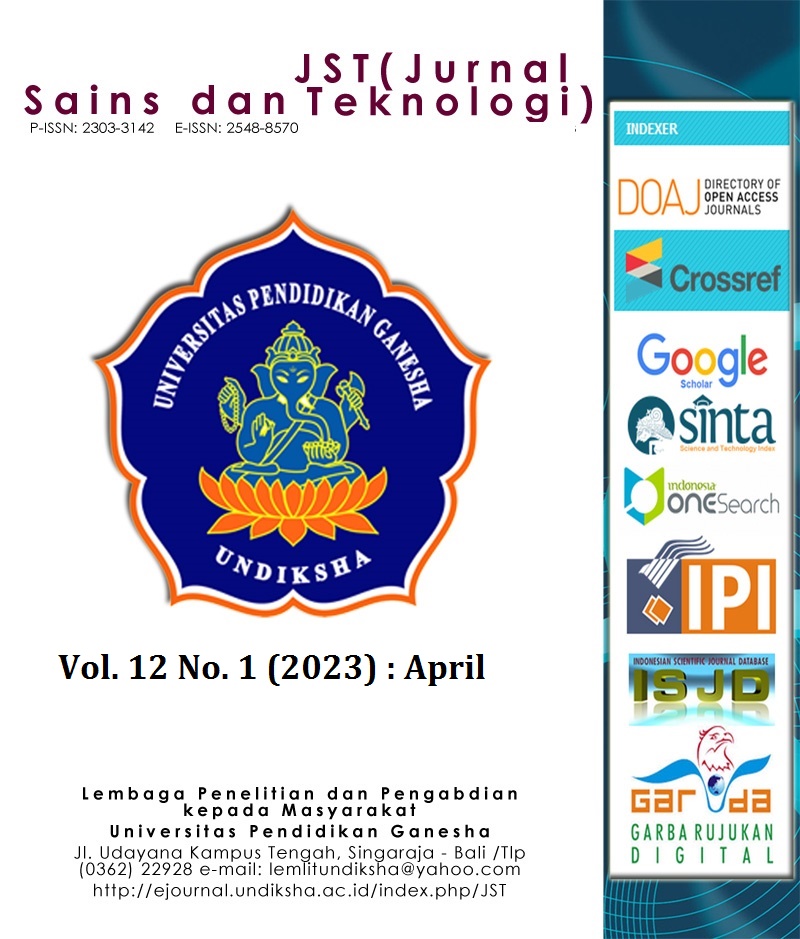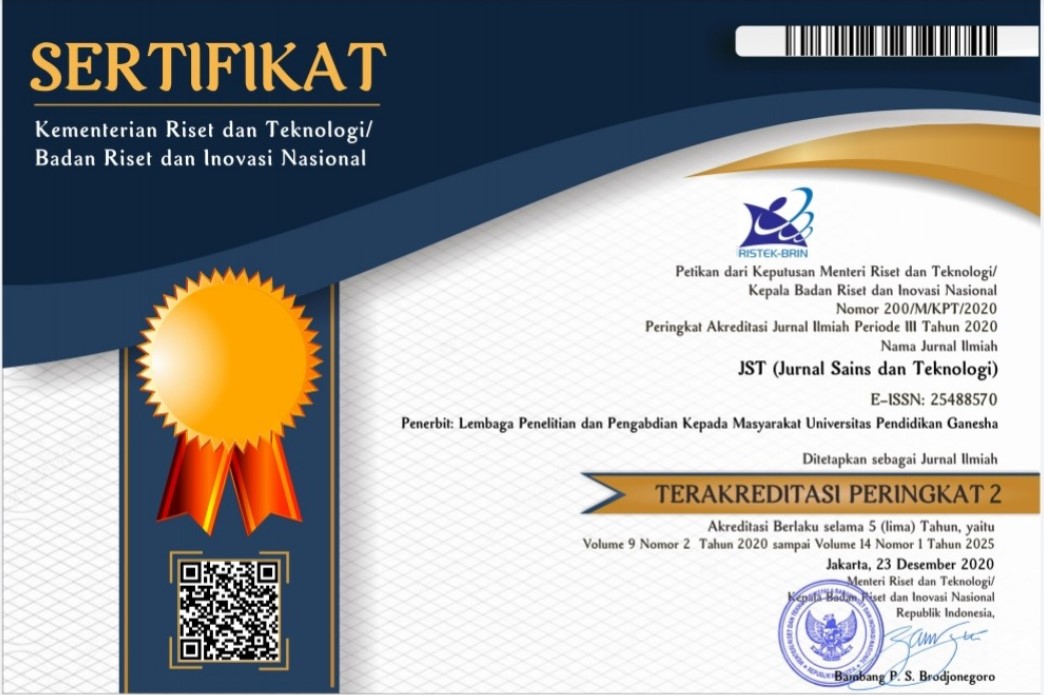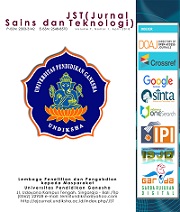GPS-Based Rocket Payload Position Tracking System
DOI:
https://doi.org/10.23887/jstundiksha.v12i1.55069Keywords:
Tracking System, Rocket Payload Payload, Global Positioning System (GPS), ArduinoAbstract
The Ministry of Research, Technology and Higher Education Indonesia routinely hosts a competition of payload tracking system placed on a rocket with a Ground Control Station (GCS), a competition known as Kompetisi Muatan Roket dan Roket Indonesia. Fixed GCS antenna causes some problems, including poor communication between payload and GCS, and position detection of the payload. This research was conducted to create a tracking system capable of moving the GCS antenna towards the payload position. In this research, we use two servos to move the antenna. This payload position tracking system works by calculating the azimuth angle of GCS coordinate and of the payload, then converting the azimuth value into the servo angle value. The calculation performs by Arduino Mega 2560 which then commands both the horizontal and vertical servos to direct the antenna towards the payload position. The experiments are performed with three main tests that are of tracking payload position based on GPS data, of antenna direction movement with servo horizontal motion direction, and of antenna direction movement with servo vertical motion direction. Testing are carried out by laying the payload on a drone and adjust the position and height of the drone manually. Experimental results show that the largest angular difference between the tracking system and the payload is 8 degrees azimuth. The mean angle difference is 4.7 degrees. This angle deviation occurs because the servo angle instruction can only be with an integer value.
References
A., A., A., D., H.A., F., & A.M., H. (2019). Flight Trajectory Control System on Fixed Wing UAV using Linear Quadratic Regulator. International Journal of Engineering Research & Technology (IJERT), 8(6). https://doi.org/10.17577/IJERTV8IS080135.
A., N., R., J., & N.F, R. (2020). Penerapan Metode Haversine Formula Untuk Penentuan Titik Kumpul pada Aplikasi Tanggap Bencana,. Metik, 4(2). https://doi.org/10.47002/metik.v4i2.190.
A.El., B., K., E. K., A., T., & H., Q. (2021). A Design of Telemetry System for Small Animals. Journal of Communications Software and Systems, 17(3), 244–253. https://doi.org/10.24138/jcomss-2021-0065.
A.M., K., & H., S. B. (2020). Transient excitation, in Structural Dynamics Fundamentals and Advanced Applications,. Science Direct.
Arduino. (2022). Arduino Mega 2560,.
Azdy, R. A., & F., D. (2020). Use of Haversine Formula in Finding Distance Between Temporary Shelter and Waste End Processing Sites. J. Phys.: Conf. Ser., 1500(012104.). https://doi.org/10.1088/1742-6596/1500/1/012104.
Buchori, I., Sugiri, A., Mussadun, M., Wadley, D., Liu, Y., Pramitasari, A., & Pamungkas, I. T. D. (2018). A predictive model to assess spatial planning in addressing hydro-meteorological hazards: A case study of Semarang City, Indonesia. International Journal of Disaster Risk Reduction, 27, 415–426. https://doi.org/10.1016/j.ijdrr.2017.11.003.
Cantanhede, N. R., Carvalho, E. E., Jesus, P. F. D. S., & Barros, J. J. De. (2022). Tracking and impact point of survey rocket by Telemetry and Slant-Range device. ENGINEERING SCIENCES, 94(3). https://doi.org/10.1590/0001-3765202220200471.
Griffiths, H. (2022). The Yagi Antenna. IEEE Aerospace and Electronic Systems Magazine, 37(1), 4–5. https://doi.org/10.1109/MAES.2021.3127141.
Hidayah, Q., Salamah, U., & Sasono, M. (2022). Analisis Uji Peluncuran Roket Air Berbasis Carbon Fiber menggunakan Sistem Telemetri. Jurnal Teori Dan Aplikasi Fisika, 10(1), 81–88. https://doi.org/10.23960%2Fjtaf.v10i1.2912.
Kelechi, A. H., Alsharif, M. H., Oluwole, D. A., Achimugu, P., Ubadike, O., Nebhen, J., … Uthansakul, P. (2021). The Recent Advancement in Unmanned Aerial Vehicle Tracking Antenna: A Review. Sensors, 21(6), 5662. https://doi.org/10.3390/s21165662.
LAPAN. (2020). LAPAN Annual Report - 2020. Lembaga Penerbangan dan Antariksa Nasional. Retrieved from https://kong.lapan.go.id/service-files/service-archives/1629424534.pdf.
Mudarris, Basirung, M. R., & Sumariyanto, I. (2022). Rocket Load Test Based On Inertial Measurement Unit Sensor In Supporting National Air Defense. Jurnal Pertahanan, 8(1), 1–10. https://doi.org/10.33172/jp.v8i1.1496.
Nugraha, I. M. A., Desnanjaya, I. G. M. N., Pranata, I. W. D., & Harianto, W. (2021). Stability Data Xbee S2b Zigbee Communication on Arduino Based Sumo Robot. Journal of Robotics and Control (JRC). https://doi.org/10.18196/jrc.2370.
Putra, A. A., & Zuhrie, M. S. (2019). Rancang Bangun Payload dan Interface Monitoring Roket dalam Visualisasi 3D dan Pengambilan Foto. 8(3),. Jurnal Teknik Elektro, 8(3), 673–678. Retrieved from https://ejournal.unesa.ac.id/index.php/JTE/article/view/29458.
R., K., P., S., K., H., J., S., Socha., L., S., & Kutílek P. (2017). Wearable Modular Telemetry System for the Integrated Rescue System Operational Use. Journal of Sensors. https://doi.org/10.1155/2017/9034253.
R.E., M., H.A., R., M., A., M., J., & M.E.M., S. (2019). An Enhanced Gain of Yagi-Uda Antenna with Folded Dipole for Amateur Radio VHF Band Application. Journal of Physics: Conference Series, 1175 01206. https://doi.org/10.1088/1742-6596/1175/1/012064.
Restrepo, C. I., Carson, J. M., Amzajerdian, F., Seubert, C., Lovelace, R., McCarthy, M., … Collins, and S. (2018). Open-Loop Performance of COBALT Precision Landing Payload on a Commercial Sub-Orbital Rocket. Session: EDL_GN&C: Entry, Descent, and Landing GN&C Technology I. https://doi.org/10.2514/6.2018-0613.
Riyandi, A., Sumardi, & Prakoso, T. (2018). PID Parameters Auto-Tuning on GPS-based Antenna Tracker Control using Fuzzy Logic. Jurnal Teknologi Dan Sistem Komputer., 6(3). https://doi.org/10.14710/jtsiskom.6.3.2018.122-128.
Salim, C. (2021). Regional Maritime Security Challenges Amongst the Indo-Pacific’s Emerging Geopolitics. In Nusantara Maritime. Indonesian Naval Command and Staff College., 1(3).
T., S., & Schlicker S. (2022). Trigonometry. Grand Valley State University.
Z.B., H., Wardi, & G., T. (2019). Low Cost Antenna Design for the Application of Over the Horizon Surface Wave Radar. International Journal of Innovative Technology and Exploring Engineering (IJITEE), 9(2), 2215–2218. https://doi.org/10.35940/ijitee.B6615.129219.
Downloads
Published
How to Cite
Issue
Section
License
Copyright (c) 2023 Dewa Made Wiharta

This work is licensed under a Creative Commons Attribution-ShareAlike 4.0 International License.
Authors who publish with the Jurnal Sains dan Teknologi (JST) agree to the following terms:
- Authors retain copyright and grant the journal the right of first publication with the work simultaneously licensed under a Creative Commons Attribution License (CC BY-SA 4.0) that allows others to share the work with an acknowledgment of the work's authorship and initial publication in this journal.
- Authors are able to enter into separate, additional contractual arrangements for the non-exclusive distribution of the journal's published version of the work (e.g., post it to an institutional repository or publish it in a book), with an acknowledgment of its initial publication in this journal.
- Authors are permitted and encouraged to post their work online (e.g., in institutional repositories or on their website) prior to and during the submission process, as it can lead to productive exchanges, as well as earlier and greater citation of published work. (See The Effect of Open Access)
















